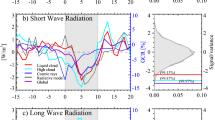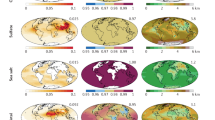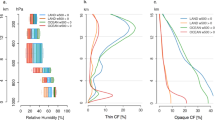Abstract
THE Earth's atmosphere has relatively high transparency to wavelengths between 8 and 14 µm, which makes them particularly important for communications and remote sensing. A reliable model of molecular absorption in this range is of particular value1 as it may be used to relate atmospheric temperatures to radiant flux measurements made by artificial satellites—it seems that even in conditions when particle scattering can be neglected, absorption losses can be greater than is expected from present models. To study the remaining loss, or anomalous absorption, we have made new measurements in which particular attention was given to the temperature dependence of the anomalous component. The motivation for this was to test the hypothesis2 that anomalous absorption could be ascribed to an equilibrium concentration of water dimers in the atmosphere. We find that this explanation cannot account for anomalous absorption in all conditions.
This is a preview of subscription content, access via your institution
Access options
Subscribe to this journal
Receive 51 print issues and online access
$199.00 per year
only $3.90 per issue
Buy this article
- Purchase on Springer Link
- Instant access to full article PDF
Prices may be subject to local taxes which are calculated during checkout
Similar content being viewed by others
References
Coffey, M. T. Q. Jl R. met. Soc. 103, 685–692 (1977).
Bignell, K. J. Q. Jl R. met. Soc. 96, 390–403 (1970).
Burch, D. E. Proc. Am. met. Soc. Conference on Atmospheric Radiation, Fort Collins, Colorado, 7–9 (August 1972).
Rowlinson, J. S. Trans. Faraday Soc. 45, 974 (1949).
Dierckson, G. H. F., Kraemer, W. P. & Roos, B. O. Theoret. chim. Acta (Berl.) 36, 249–274 (1975).
Curtiss, L. A. & Pople, J. A. J. molec. Spectrosc. 55, 1–14 (1975).
Ivanov, V. M. & Savitskiy . Atmos. Oceanic Phys. 12, 261–262 (1976).
Korty, B., Gelman, M. & Finger, F. COSPAR, Space Research Vol. XVIII, 53–56 (1977).
Bohlander, R. A. & Gebbie, H. A. Nature 253, 523–525 (1975).
Llewellyn-Jones, D., Knight, R. J. & Gebbie, H. A. Nature 274, 876–878 (1978).
Lee, A. C. L. Q. Jl R. met. Soc. 99, 490–505 (1973).
Gross, E. P. Phys. Rev. 97, 395–403 (1955).
Zhevakin, S. A. & Naumov, A. P. Izv. Vyssh. Ucheb. Zaved. Radiofiz. 6, 674–694 (1963).
Emery, R. J. Appl. Opt. 7, 1247 (1968).
McClatchey, R. A. et al. AFCRL Atmospheric Absorption Line Parameter Compilation, AFCRL-TR-73-0096 (1973).
Benedict, W. S. & Kaplan, L. D. J. quant. Spectrosc. Radiat. Transfer 4, 453–469 (1964).
Author information
Authors and Affiliations
Rights and permissions
About this article
Cite this article
ZAVODY, A., EMERY, R. & GEBBIE, H. Temperature dependence of atmospheric absorption in the wavelength range 8–14 µm. Nature 277, 462–463 (1979). https://doi.org/10.1038/277462a0
Received:
Accepted:
Issue Date:
DOI: https://doi.org/10.1038/277462a0
This article is cited by
-
Field and laboratory experiments on the 8 to 14 ?m spectral window of the terrestrial atmosphere
International Journal of Infrared and Millimeter Waves (1986)
-
Temperature dependence of the IR water-vapor absorption
International Journal of Infrared and Millimeter Waves (1984)
-
Resonant absorption by water polymers in the atmosphere
Nature (1982)
Comments
By submitting a comment you agree to abide by our Terms and Community Guidelines. If you find something abusive or that does not comply with our terms or guidelines please flag it as inappropriate.



